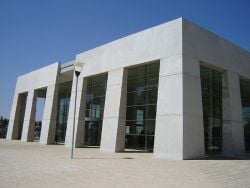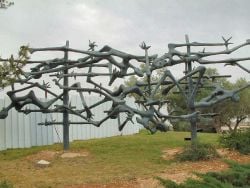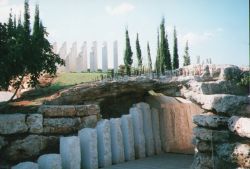Yad Vashem
| Geography |
|---|
|
Land of Israel · Districts · Cities |
| History |
|
Jewish history · Timeline · Zionism · Aliyah |
| Arab-Israeli conflict · Proposals |
|
1948 War · 1949 Armistice · Suez War |
| Israeli-Palestinian conflict |
|
Timeline · Peace process · Peace camp |
| Economy |
|
Science and technology · Companies |
| Demographics · Culture |
|
Religion · Israeli Arabs · Kibbutz |
| Laws · Politics |
|
Law of Return · Jerusalem Law |
| Foreign affairs |
|
International law · UN · US · Arab League |
| Security |
|
Israel Defense Forces |
|
Portal |
Yad Vashem (יד ושם) - ("Holocaust Martyrs' and Heroes' Remembrance Authority") - is Israel's official memorial to the victims of the Holocaust established in 1953 through the Memorial Law passed by the Knesset, Israel's parliament.
The origin of the name is from a Biblical verse: "And to them will I give in my house and within my walls a memorial and a name … that shall not be cut off." (Isaiah, chapter 56, verse 5) In Hebrew, "a memorial and a name" translates as yad va-shem.
Located in Jerusalem, it consists of a memorial chamber, a historical museum, an art gallery, a Hall of Names, an archive, the "Valley of the Destroyed Communities", a synagogue, and an educational centre. As well, non-Jews who saved Jews during the Holocaust, often at great personal risk, are honoured by Yad Vashem as the "Righteous Among the Nations".
Layout
The new Holocaust History Museum was built as a prism-like triangular structure. It is 180 meters long, with stark walls made from reinforced concrete. The museum covers an area of more than 4,000 square meters and is mostly situated below ground level.
There are 10 exhibition halls, each devoted to a different chapter in the history of the Holocaust. Unlike the exhibition in the old museum, which was primarily composed of photographs, the new exhibition comprises many elements, including 280 works of art and 2,500 presentations and personal artifacts donated to Yad Vashem by Holocaust survivors, museums and memorial sites around the world.
Activities
Yad Vashem coordinates the following activities:
- Documentation:
- recording testimonies of survivors
- collecting the names of those who perished during the Holocaust [1]
- collecting photos, documents and resources regarding the Holocaust
- Research and studies:
- conducting research regarding the Holocaust
- encouraging students to research the Holocaust
- publishing research and making it available to the general public
- Education:
- operating the International School for Holocaust Studies [2]
- developing study programs for both Israeli and foreign schools in order to teach young students about the Holocaust
- holding exhibitions about the Holocaust
- teaching about the Holocaust to the general public
- Memorial:
- preserving the memory and names of those who died during the Holocaust
- holding ceremonies of remembrance
Museum
In 1993, the Yad Vashem institute decided to build a larger museum to replace the one built during the 1960s. This was in response to the construction of larger Holocaust museums in Washington D.C. and Europe. The new museum is the largest Holocaust museum in the world. It is carved into the mountain and designed to reflect the story of the European Jewish community during the Holocaust and their resurrection from the ashes in Israel. It consists of a long corridor with 10 exhibition halls, each dedicated to a different chapter of the Holocaust. The museum combines the personal stories of 90 Holocaust victims and survivors and presents in its exhibitions about 2500 personal items: artworks and letters from the Holocaust donated by survivors. The new museum also includes an auditorium, study hall, computerized data bank and memorial monuments of the more than six million Jews murdered during the Holocaust. Since the 1950s, Yad Vashem has collected approximately 44,000 taped testimonies by Holocaust survivors; as the survivors age and are beginning to become less mobile, the program has expanded to visiting survivors in their homes to tape interviews.
On March 15, 2005, the dedication of the new Yad Vashem Holocaust museum in Jerusalem, Israel took place. The impressive building was designed by the worldwide renowned Jewish architect, Moshe Safdie. Leaders from 40 states and the Secretary General of the UN Kofi Annan attended the inauguration of Holocaust museum. President of Israel Moshe Katzav said that the new museum serves as "an important signpost to all of humankind, a signpost that warns how short the distance is between hatred and murder, between racism and genocide." [3] The building's triangular architectural-shape is said to represent the bottom half of a Star of David, because the world's Jewish population was cut in half as a result of the Holocaust.
Righteous Among the Nations
Righteous among the Nations (Hebrew: חסידי אומות העולם, Hasidei Umot HaOlam), which may at times refer to the B'nei Noah or Noahides as well, is a term used in Judaism to refer to non-Jews who abide by the Noahide Laws (the Seven Laws of Noah) and thus are assured of meriting paradise. In contemporary usage, the term is used by the State of Israel to describe non-Jews who risked their lives during the Holocaust in order to save Jews from extermination by the Nazis.
Since 1963, a commission headed by a justice of the Supreme Court of Israel has been charged with the duty of awarding the honorary title "Righteous Among the Nations." The commission is guided in its work by certain criteria and meticulously studies all documentation, including evidence by survivors and other eyewitnesses. A person who is recognized as Righteous Among the Nations for helping Jews during the Holocaust is awarded a medal bearing his name, a certificate of honor, and the privilege of having his name added to those on the Wall of Honor in the Garden of the Righteous at Yad Vashem in Jerusalem, the Israeli Holocaust Memorial. (The last is in lieu of a tree-planting, which was discontinued for lack of space.) The awards are distributed to the rescuers or their next-of-kin during ceremonies in Israel or in their countries of residence through the offices of Israel's diplomatic representatives. These ceremonies are attended by local government representatives and are given wide media coverage.
The Yad Vashem Law authorizes Yad Vashem
- "To confer honorary citizenship upon the Righteous Among the Nations, and if they have passed away, the commemorative citizenship of the State of Israel, in recognition of their actions."
Anyone who has been recognized as Righteous Among the Nations is entitled to apply to Yad Vashem for the certificate. If the Righteous Among the Nations is no longer alive, their next of kin is entitled to request that commemorative citizenship be conferred on the Righteous Among the Nations who has died. To date, more than 21,700 people[1], including family members who shared in the rescue of Jews, have been recognized as Righteous Among the Nations, representing over 8,000 authenticated rescue stories. Yad Vashem's policy is to pursue the program for as long as petitions for this title are received and are supported by solid evidence that meets the criteria.
The museum also honors the Righteous Among the Nations. For example, a small garden and plaque on the grounds of Yad Vashem is dedicated to the people of Le Chambon-sur-Lignon in France who, during World War II, made their town a haven for Jews fleeing from the Nazis.
A few of the more than 20,000 non-Jews so honoured:
- Władysław Bartoszewski
- Johan Benders
- Corrie ten Boom
- Archbishop Damaskinos
- Gottfried von Einem
- Varian Fry
- Miep Gies
- Marie-Rose Gineste
- Hermann Friedrich Graebe
- Aristides Sousa Mendes
- Czesław Miłosz
- Dorothea Neff
- Jonas Paulavicius
- Frits Philips
- Karl Plagge
- Traian Popovici
- Oskar Schindler and Emilie Schindler
- Irena Sendler
- Suzanne Spaak
- Chiune Sugihara
- André Trocmé
- Magda Trocmé
- Raoul Wallenberg
- Johan Hendrik Weidner
- Wilm Hosenfeld
- Alexandre Glasberg
- Feng Shan Ho
- Dimitar Peshev
Trivia
In 2000 German Chancellor Gerhard Schröder visited Yad Vashem as a guest of Israeli Premier Ehud Barak and was invited to turn a handle to boost the Eternal Flame. In a much reported diplomatic gaffe he turned the handle the wrong way and extinguished it [4] [5] [6].
Notes
- ↑ "First Arab Nominated for Holocaust Honor", Associated Press, 2007-01-30. Retrieved 2007-02-01.
References and additional reading
- Gushee, David. 2004. Righteous Gentiles of the Holocaust: genocide and moral obligation. New York: Paragon House. ISBN 1557788219 and ISBN 9781557788214
- Klempner, Mark. 2006. The heart has reasons: Holocaust rescuers and their stories of courage. Cleveland, Ohio: Pilgrim Press. ISBN 0829816992 and ISBN 9780829816990
- Land-Weber, Ellen. 2000. To save a life: stories of Holocaust rescue. Urbana: University of Illinois Press. ISBN 0252025156 and ISBN 9780252025150
- Lichtenstein, Aaron. 1981. The seven laws of Noah. New York: Rabbi Jacob Joseph School Press.
- Novak, David. 1983. The image of the non-Jew in Judaism: an historical and constructive study of the Noahide Laws. Toronto studies in theology, v. 14. New York: E. Mellen Press. ISBN 0889467595 and ISBN 9780889467590
- Paldiel, Mordecai. 1993. The path of the righteous: gentile rescuers of Jews during the Holocaust. Hoboken, N.J.: Ktav. ISBN 0881253766 and ISBN 9780881253764
- Satloff, Robert B. 2006. Among the righteous: lost stories from the Holocaust's long reach into Arab lands. New York: PublicAffairs. ISBN 1586483994 and ISBN 9781586483999
- Satloff, Robert B. 2006. Among the righteous: lost stories from the Holocaust's long reach into Arab lands. New York: PublicAffairs. ISBN 0195051947 and ISBN 9780195051940
- Tomaszewski, Irene, and Tecia Werbowski. 1999. Żegota: the Council for Aid to Jews in Occupied Poland, 1942-45. Montreal, Quebec, Canada: Price-Patterson. ISBN 1896881157 and ISBN 9781896881157
- Neusner, Jacob, Alan J. Avery-Peck, and William Scott Green. 2005. The encyclopaedia of Judaism. Leiden: Brill. ISBN 900414787X and ISBN 9789004147874
- Hellman, Peter. 1999. When courage was stronger than fear: remarkable stories of Christians who saved Jews from the Holocaust. New York: Marlowe. ISBN 1569246637 and ISBN 9781569246634
External links
- Interactive guide to Holocaust History Museum. Haaretz. Retrieved May 20, 2007.
- Vashem. Canadian Society for Yad Vashem. Retrieved May 20, 2007.
- Károly Szabó - his role among Wallenberg’s supporters 1944-45. Hightech Marketing-Service. Retrieved May 20, 2007.
- Show Trial Preparations 1953 in Hungary. What's new about Raoul Wallenberg? Retrieved May 20, 2007.
- Yad Vashem. Go into all the Wolrd. Retrieved May 20, 2007.
- Yad Vashem. Go Jerusalem. Retrieved May 20, 2007.
Credits
New World Encyclopedia writers and editors rewrote and completed the Wikipedia article in accordance with New World Encyclopedia standards. This article abides by terms of the Creative Commons CC-by-sa 3.0 License (CC-by-sa), which may be used and disseminated with proper attribution. Credit is due under the terms of this license that can reference both the New World Encyclopedia contributors and the selfless volunteer contributors of the Wikimedia Foundation. To cite this article click here for a list of acceptable citing formats.The history of earlier contributions by wikipedians is accessible to researchers here:
The history of this article since it was imported to New World Encyclopedia:
Note: Some restrictions may apply to use of individual images which are separately licensed.



